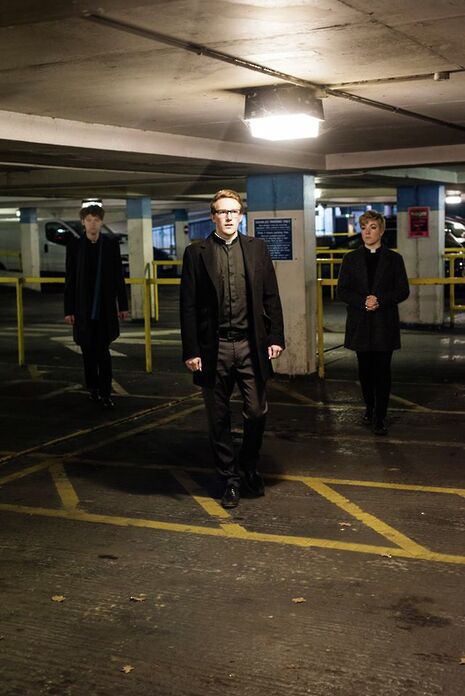Racing Demon
An overall enjoyable, yet difficult, play to watch, says Olivia Choudhury

Director Will Bishop and Assistant Director Riss Obolensky’s production of David Hare’s play, Racing Demon, is an interesting take on a piece of work that challenges and subverts any preconceptions you may have about the Church or religion. A brave script in itself, the play throws up a series of difficult questions regarding Christian morals, the hard mix of politics within religion and the question of a loving God.
Heather Farnham, playing the role of ‘Streaky’, easily steals the show as a light-hearted character who is not afraid to be serious when the time is right. Established as a character who is seen to bring comic relief to an otherwise relatively down-to-earth plot, Heather manages to characterise Streaky to perfection, a talent that is emphasised by her drunken monologue in the form of a conversation with God. The cast as a whole worked fluidly and efficiently together, with each actor using the body language and dialogue of others to create a dramatically enticing tension in the atmosphere. Some of the dialogue was unintelligible when passions rose and a few of the actors tended to talk a tad too fast, but the overarching motif of difficult relationships was, nevertheless, achieved well.
The script of Racing Demon brought challenging questions regarding both religion and Christianity itself to the forefront of the audience’s mind. However, towards the end of the play, the pace seemed to drag, and the script became a little stilted. This was combatted effectively by the actors’ use of silences, split-screens and reactions to various plot twists. This, as well as the increased tension throughout the play, worked together to keep it from seeming too long. Among the challenges brought forward were those of abortion, sex before marriage and homosexuality. Tying together all of these was the theme of the Church’s reaction to these individual topics and the difficult juxtaposition of individual Church members’ opinions.
The set was minimal, thereby allowing the focus to be on the characters themselves and the dialogue they were using to wade through difficult issues. The lighting was also minimal, although an effective use of colour within the lighting was used well to emphasise tensions running high. There were some scenes that did not seem necessary to the plot, such as the opening scene, which portrayed all the characters standing silently on a train, but the use of set and lighting throughout complemented the actors’ characterisations and tied the play together well. The acting, directing and technical sides of Racing Demon came together to make an overall enjoyable, yet difficult, play to watch.
 News / Police to stop searching for stolen Fitzwilliam jade17 April 2024
News / Police to stop searching for stolen Fitzwilliam jade17 April 2024 Interviews / ‘It fills you with a sense of awe’: the year abroad experience17 April 2024
Interviews / ‘It fills you with a sense of awe’: the year abroad experience17 April 2024 News / Night Climbers call for Cambridge to cut ties with Israel in new stunt15 April 2024
News / Night Climbers call for Cambridge to cut ties with Israel in new stunt15 April 2024 Sport / Kabaddi: the ancient sport which has finally arrived in Cambridge17 April 2024
Sport / Kabaddi: the ancient sport which has finally arrived in Cambridge17 April 2024 Features / Cambridge’s first Foundation Year students: where are they now?7 April 2024
Features / Cambridge’s first Foundation Year students: where are they now?7 April 2024





